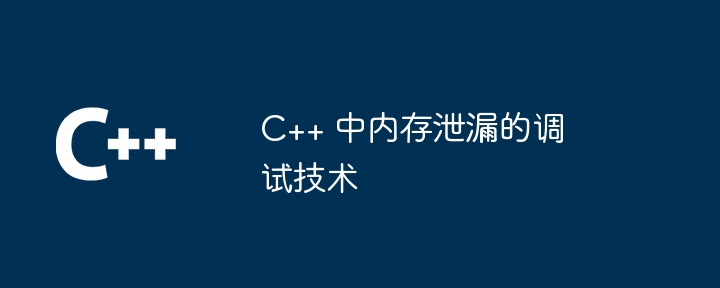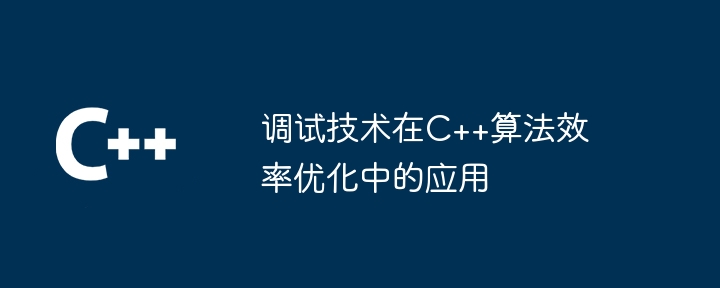 Backend Development
Backend Development C++
C++ Application of debugging technology in C++ algorithm efficiency optimization
Application of debugging technology in C++ algorithm efficiency optimizationDebugging techniques can help optimize the efficiency of C++ algorithms through the use of log statements, breakpoints, single-stepping, and performance analysis tools. Practical examples include optimizing the bubble sort algorithm and improving performance by introducing the isSorted flag to avoid unnecessary loops.

Application of debugging technology in C++ algorithm efficiency optimization
In C++ algorithm development, debugging technology is crucial. It can help identify and solve efficiency bottlenecks to optimize algorithm performance. The following are some commonly used debugging techniques and practical cases:
1. Use log statements
Log statements can output key information during algorithm execution to help locate problems. For example:
// 定义一个日志函数
void log(const std::string& message) {
std::cout << "[LOG] " << message << std::endl;
}
int main() {
log("开始算法");
// 算法代码
log("算法结束");
return 0;
}2. Using breakpoints and single-stepping
The breakpoints and single-stepping functions in the debugger can be used to inspect the algorithm execution line by line. For example:
- ##Breakpoint: Set a breakpoint at the line of code that needs to be checked, and the program will pause when it reaches the breakpoint.
- Single-step execution: Execute the algorithm step by step, and you can observe changes in variable values and execution processes.
3. Use performance analysis tools
Performance analysis tools can analyze the execution time and resource usage of the code to identify efficiency bottlenecks. For example:- Visual Studio: You can use the built-in performance analyzer.
- gprof: A command line tool that can be used to analyze function calls and profiling information of a program.
Practical case: Optimizing sorting algorithm
The following is a practical case of optimizing the bubble sorting algorithm:// 未优化的冒泡排序
void bubbleSort(int* arr, int n) {
for (int i = 0; i < n; ++i) {
for (int j = 0; j < n - i - 1; ++j) {
if (arr[j] > arr[j + 1]) {
swap(arr[j], arr[j + 1]);
}
}
}
}
// 优化的冒泡排序
void bubbleSortOptimized(int* arr, int n) {
bool isSorted = false;
while (!isSorted) {
isSorted = true;
for (int j = 0; j < n - 1; ++j) {
if (arr[j] > arr[j + 1]) {
swap(arr[j], arr[j + 1]);
isSorted = false;
}
}
}
}After optimization In the algorithm, a isSorted flag is introduced. When no elements need to be exchanged, the flag becomes true to avoid unnecessary loops.
The above is the detailed content of Application of debugging technology in C++ algorithm efficiency optimization. For more information, please follow other related articles on the PHP Chinese website!
 C++ 中内存泄漏的调试技术Jun 05, 2024 pm 10:19 PM
C++ 中内存泄漏的调试技术Jun 05, 2024 pm 10:19 PMC++中内存泄漏是指程序分配了内存但忘记释放,导致内存无法被重用。调试技术包括使用调试器(如Valgrind、GDB)、插入断言和使用内存泄漏检测器库(如Boost.LeakDetector、MemorySanitizer)。通过实践案例展示了使用Valgrind检测内存泄漏,并提出了避免内存泄漏的最佳做法,包括:始终释放分配的内存、使用智能指针、使用内存管理库和定期进行内存检查。
 在ThinkPHP6中使用Xdebug调试技术Jun 20, 2023 pm 09:14 PM
在ThinkPHP6中使用Xdebug调试技术Jun 20, 2023 pm 09:14 PMThinkPHP6是一个流行的PHP框架,它使用了多种技术让开发变得更加便利。其中一个技术是调试工具,如Xdebug。在这篇文章中,我们将探讨如何在ThinkPHP6中使用Xdebug进行调试。安装与配置Xdebug在开始使用Xdebug前,首先需要安装和启用它。在php.ini文件中,可以添加以下配置:[xdebug]zend_extension=x
 掌握Eclipse调试和错误排查技巧:解决问题的绝佳方法Jan 28, 2024 am 09:31 AM
掌握Eclipse调试和错误排查技巧:解决问题的绝佳方法Jan 28, 2024 am 09:31 AM解决问题的利器:掌握Eclipse调试和错误排查技术,需要具体代码示例引言:在我们的日常开发过程中,经常会遇到各种各样的问题。有些问题很容易被发现和解决,但也有些问题却让我们头疼不已。为了有效地解决这些问题,掌握Eclipse调试和错误排查技术是非常重要的。本文将详细介绍Eclipse调试和错误排查技术,并给出具体的代码示例。一、什么是Eclipse调试和错
 Python实现的Web应用程序调试技术Jun 17, 2023 pm 09:12 PM
Python实现的Web应用程序调试技术Jun 17, 2023 pm 09:12 PM随着Web应用程序的发展,开发过程中遇到的问题也日益复杂多样。其中调试是一个必要且常见的环节,它可以帮助开发者快速定位并解决问题,提高开发效率。Python作为目前最热门的编程语言之一,其在Web应用程序开发中也占有非常重要的地位。在本文中,我们将介绍Python实现的Web应用程序调试技术,以及如何使用这些技术快速定位并解决问题。一、Python应用程序调
 C++算法优化实践:提高算法效率的实用技巧Nov 27, 2023 am 09:48 AM
C++算法优化实践:提高算法效率的实用技巧Nov 27, 2023 am 09:48 AM随着计算机应用的日益普及,算法效率成为了越来越多程序员关注的问题。对于C++语言这样的高级语言而言,尽管其编译器可以进行一定的优化,但在实际应用场景中,算法的效率优化仍然起着至关重要的作用。本文将介绍一些C++算法优化的实用技巧,帮助读者提高算法效率。算法选择首先考虑采用合适的算法是最基本的优化方式。对于非常规问题,我们应该综合考虑数据规模、时间复杂度、空间
 PHP中的日志和调试技术May 11, 2023 am 08:39 AM
PHP中的日志和调试技术May 11, 2023 am 08:39 AMPHP是一门广泛应用的编程语言,具有灵活性和易于学习的特点。在开发和维护Web应用程序时,日志和调试技术是不可或缺的。在PHP中,有多种方式可以实现日志和调试,这些技术可以帮助开发人员追踪错误和调试代码。一、日志技术1.1日志的作用日志是记录应用程序运行过程中所发生事件的一种手段,可以帮助开发人员了解应用程序在不同时间点所做出的决策。1.2PHP的日志系
 Java 中的测试和调试技术Jun 09, 2023 am 09:03 AM
Java 中的测试和调试技术Jun 09, 2023 am 09:03 AMJava是一门非常流行的编程语言,因为它具有可移植性,易于学习和使用,还有一个强大的社区支持。测试和调试是编写高质量软件不可避免的步骤。在本文中,我们将探讨Java中的测试和调试技术,帮助您更好地理解如何编写可靠的Java应用程序。一、测试技术测试是指在软件开发的不同阶段,通过各种手段评估和验证软件的正确性、完整性、有效性、可靠性、安全性等质量属性
 调试技术在C++算法效率优化中的应用Jun 06, 2024 am 10:33 AM
调试技术在C++算法效率优化中的应用Jun 06, 2024 am 10:33 AM通过使用日志语句、断点、单步执行和性能分析工具,调试技术可以帮助优化C++算法的效率。实战案例包括优化冒泡排序算法,通过引入isSorted标志位以避免不必要的循环,从而提高性能。


Hot AI Tools

Undresser.AI Undress
AI-powered app for creating realistic nude photos

AI Clothes Remover
Online AI tool for removing clothes from photos.

Undress AI Tool
Undress images for free

Clothoff.io
AI clothes remover

AI Hentai Generator
Generate AI Hentai for free.

Hot Article

Hot Tools

mPDF
mPDF is a PHP library that can generate PDF files from UTF-8 encoded HTML. The original author, Ian Back, wrote mPDF to output PDF files "on the fly" from his website and handle different languages. It is slower than original scripts like HTML2FPDF and produces larger files when using Unicode fonts, but supports CSS styles etc. and has a lot of enhancements. Supports almost all languages, including RTL (Arabic and Hebrew) and CJK (Chinese, Japanese and Korean). Supports nested block-level elements (such as P, DIV),

ZendStudio 13.5.1 Mac
Powerful PHP integrated development environment

Zend Studio 13.0.1
Powerful PHP integrated development environment

SublimeText3 Chinese version
Chinese version, very easy to use

Safe Exam Browser
Safe Exam Browser is a secure browser environment for taking online exams securely. This software turns any computer into a secure workstation. It controls access to any utility and prevents students from using unauthorized resources.





